Once native forests, now just ‘paddock trees’
Saturday, January 14th, 2012 A ‘paddock tree’ in Australia – valued by farmers for their livestock shade
A ‘paddock tree’ in Australia – valued by farmers for their livestock shadeAlso a desperate refuge for remnant wildlife, long denied their entire friggin forest!
.
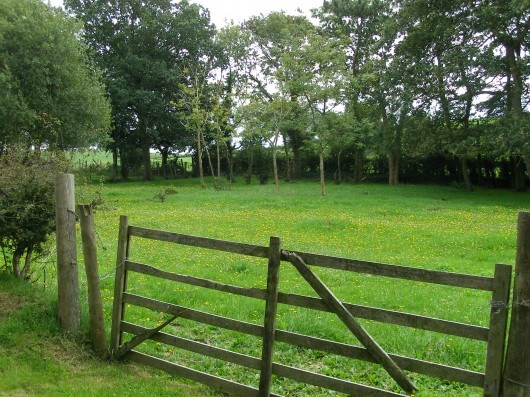 A 19th Century farm meadow in Northern Ireland
Ulster American Folk Park, Castletown, Northern Ireland
(Photo by Editor 20060904, free in public domain, click photo to enlarge)
A 19th Century farm meadow in Northern Ireland
Ulster American Folk Park, Castletown, Northern Ireland
(Photo by Editor 20060904, free in public domain, click photo to enlarge)
.
In a native forest, old trees naturally die and saplings germinate from the seed of their parent trees. Native forests are living regenerating ecosystems.
But when humans destroy and disturb forest ecology, the forests change. When humans destroy complete forests and leave a few token shade-providing ‘paddock trees‘ in deforested paddocks, and livestock fertilize the thin fragile soils, humans completely deny forest ecological succession. Isolated trees are isolated trees, so they die. Dieback is one such outcome – suitably named; that is ‘Deforestation Dieback‘ as distinct from the disease ‘Phytophthora dieback‘.
And now some are crying foul out over losing these token ‘paddock trees‘, despite the loss of the entire original forest not getting a mention. This is such anthropocentric bias. The 19th Century William Wordsworth/John Constable pastoral romanticism of what the English countryside ought to look like became the colonial vision for Australia from 1788. It is this inherited notion of a ‘Colonial Bucolic Vista‘ and disturbingly it’s legacy still pervades Australian agricultural culture.
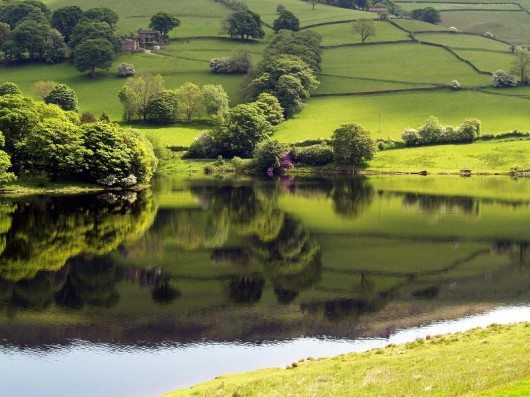 A classic vision of the bucolic English countryside
– where centuries of native heritage, agrarian culture and constant rainfall…permit.
A classic vision of the bucolic English countryside
– where centuries of native heritage, agrarian culture and constant rainfall…permit.
.
‘Reversing a tree regeneration crisis’ (Dr Joern Fischer)
.
[Source: ‘Reversing a tree regeneration crisis’, by Dr Joern Fischer, Fenner School of the Environment and Society, ANU College of Medicine Biology and Environment, Summer 2009, Australian National University, ^http://news.anu.edu.au/?p=1725].
According to Australian National University (ANU) research published in the US-based ‘Proceedings of the National Academy of Sciences (2009):
.
‘Australia’s south-east temperate grazing region could be virtually treeless within decades.‘
.
‘The research team concluded that most of the trees scattered across millions of hectares of temperate grazing land in New South Wales and Victoria re old and close to death. Existing land management practices (Ed: aka broadscale deforestation) have prevented regeneration of young trees to replace them. The study pointed out that disappearance of ‘paddock trees’ would lead to loss of shelter for livestock, loss of habitat for birds and other wildlife, decreasing water infiltration and other detrimental flow-on effects over the entire ecosystem.
.
(Ed: Is there any trace of a native forest ecosystem on rural farm holdings? These shade tree deprived farmers didn’t complain when they were massacring Australian native forests. A treeless wasteland is the consequence of deforestation, you fools!)
.
Dr Joern Fischer from the Fenner School of the Environment and Society says:
“Under existing management practices, millions of hectares of grazing country, currently supporting tens of millions of trees, will be treeless within decades from now,” “And the loss of this tree cover is predicted to lead to massive declines in biodiversity and grazing productivity.” Dr Fischer’s Sustainable Farms research group has spent the last couple of years documenting the extent of the tree regeneration failure and has been investigating if the situation can be reversed by changing land management.
“Although clearing has largely stopped, tree cover continues to decline because many existing trees are dying of old age, and few young trees are regenerating,” says Fischer. “We studied a 1,000,000 hectare area in the Upper Lachlan catchment of New South Wales. Typical paddock trees are often over 140 years old, and in many locations, no young trees have regenerated for decades.”
ANU’s Dr Joern Fischer’s research found that ‘(native) trees are more likely to regenerate in unfertilised pastures under high -intensity rotational grazing than under conventional, continuous grazing. Fischer states that the study found that maintaining tree cover over vast areas cannot be done without Nature’s help – that is to say via natural regeneration. Therefore, farm ecosystems must become self-sustaining, allowing for natural tree regeneration while also providing an income to farmers.
.
(Editor: What brilliant insight! I hope the taxpayer didn’t fund such lay findings).
.
According to Tim Wetherill, ‘paddock trees‘ provide shelter for livestock, homes for native animals, barriers against soil erosion and a host of other benefits. They’re an icon of the Australian countryside’.
[Source: ‘Reversing a tree regeneration crisis’, by Tim Wetherill, ANU News, Summer 2009, ^http://news.anu.edu.au/?p=1725] . (Editor: “An icon of the Australian countryside” What colonial Pastoral Romanticism! What about the more important values of intact native forests before the farmers clearfelled them, burnt the remains and dragged the topsoil under plough? .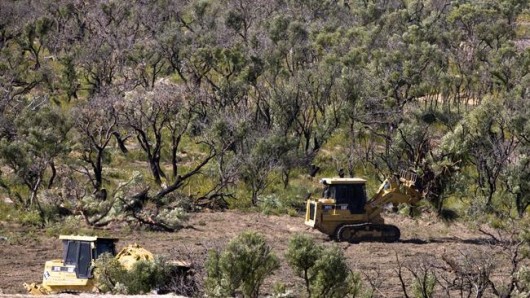 The decidedly browner, drier reality of Australia’s fragile disappearing native vegetation
Nature on the run: Hundreds of hectares of native animal habitat is bulldozed for a new housing development in Perth’s outer suburbs this year.
(Source: Perth Now, Photo by World Wildlife Fund, Australia 2009)
The decidedly browner, drier reality of Australia’s fragile disappearing native vegetation
Nature on the run: Hundreds of hectares of native animal habitat is bulldozed for a new housing development in Perth’s outer suburbs this year.
(Source: Perth Now, Photo by World Wildlife Fund, Australia 2009)
.
Fischer’s report continues…
.
‘It’s long been known that paddock trees in much of Australia’s temperate grazing region are not regenerating. With every year we lose a few more as the old trees die but nothing is coming through to replace them. In recent years there’s been a growing realisation that the situation is rapidly evolving into a crisis.
“Our study identified a short list of management options for maintaining paddock trees,” says Fischer. “In some areas, natural regeneration is unlikely in the short term, for example because there are few parent trees, or because soil nutrient levels are high. In such areas, scattered trees can be planted with re-usable tree guards that protect individual trees from livestock – some pioneering farmers are doing this already. Another option is to temporarily exclude livestock from a paddock prior to re-seeding it and resting it for several years – an approach successfully used by Greening Australia in the Canberra region.”
“Our findings suggest that self-perpetuating farm ecosystems with farms trees can be created by applying high intensity rotational grazing with long rest periods, and by phasing out fertiliser use,” explains Fischer. “Even where these practices are adopted, changes in tree regeneration will not occur overnight. But unless significant changes in management are introduced now, old trees will continue to disappear, and opportunities for natural regeneration will continue to be lost.
“The future of Australia’s paddock trees depends on urgent and widespread management action. While mature trees still exist, they provide regeneration nuclei throughout the landscape, thereby offering a window of opportunity to reverse the tree regeneration crisis.”
.
Editor: Fischer’s quest to save ‘paddock trees’ is ecologically ‘penny wise, pound foolish’.
If Fischer’s aim is to have paddock trees regenerate so that farmers’ livestock may continue to have shade from the sun, then farmers can jolly well plant out their own shade trees – simple problem solved cheaply. Farmers could even propagate their own.
If Fischer’s aim is to maintain the 19th Century notion of the colonial bucolic vista, then he is disingenuous about forest ecosystem regeneration and ought to transfer from Science to Arts and study English Romanticism .
If Fischer’s aim is science-based forest ecosystem regeneration, then he should revisit the ANU Library and grab some appropriate books on forest ecosystem regeneration and realise that it is a tad more than about saving ‘paddock trees’).
.
Behold the Colonial Bucolic Vista! …derived from 18th and 19th Century Pastoral Romanticism…achieved by clearfelling, ploughing, fertilising, grazing and leaving a few token ‘paddock trees’.
.
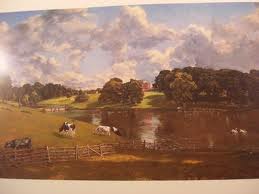 ‘Wivenhoe Park, Essex’
by 19th Century English Romantic painter John Constable
‘Wivenhoe Park, Essex’
by 19th Century English Romantic painter John Constable
.
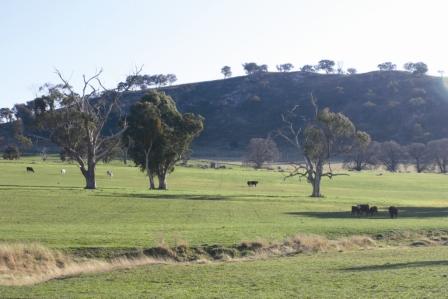 The colonial conversion of Australia
The colonial conversion of Australia
.
‘Older paddock trees are dying at a rapid rate’ (M. Sheahan)
.
[Source: ‘Isolated Trees’, by M. Sheahan, Murray Catchment Management Committee/Department of Land & Water Conservation, Border Rivers-Gwydir – Catchment Management Authority, ^http://brg.cma.nsw.gov.au/index.php?page=isolated-trees]
.
‘When the land was cleared for grazing and agriculture, isolated ‘shade’ trees were left across the landscape. These isolated trees are, in many areas, all that remain of the native vegetation which once covered the land. As time passes, these trees are aging and dying, sometimes prematurely. If no action is taken to prevent their decline or replace them, we will be left with a treeless land – exacerbating land degradation and changing the face of a familiar landscape.
.
What are isolated trees?
.
Isolated trees can be defined as ‘trees around which the other components of a native vegetation community have been removed’. In some vegetation communities, like Open Woodland, the trees are naturally well-spaced. Trees in these communities are not considered to be ‘isolated’, if the vegetation community they are a part of generally remains intact.
.
The values of isolated trees
.
Isolated trees have a range of important values, including:
- Scenic and aesthetic value – isolated trees are, in many instances, what gives the Australian landscape its unique character. What would your area look like if all the isolated trees had gone?
- Shade – isolated trees provide shade for stock, enhancing livestock performance by preventing heat stress.
- Nesting sites for wildlife – many isolated trees are old, and commonly they have hollows. These hollows are used by many species of native animals, including birds, insect-eating bats and mammals. A third of all woodland birds require hollows for nesting, so these old trees may be the only place in the landscape where these species can breed. Hollows only begin to form in Eucalypts after about 100 years – the trees you plant today will take at least this long to replace the old isolated trees.
- Feeding sites for wildlife
.
A 300 year old Grey Box (Eucalyptus microcarpa) with a height of 20 metres and a diameter of 1.5 metres has a bark area of about 94 sq. metres. In comparison, a 20 year old tree which is 15 metres high with a diameter of 20cm has a bark surface area of just 9 metres. This extra bark (10 times more on the old tree) supports a diversity of insect life which can provide 10 times more food for insect eating birds. Healthy mature trees also produce more nectar, foliage and fruits than young trees, as the younger trees put more energy into growth in height.
.
Connective value
.
- Isolated trees can act like ‘stepping stones’, enabling birds and other species to move across the landscape.
- Fallen limbs – fallen limbs provide habitat for a range of ground-dwelling species.
- Nutrient cycling – the deep roots of isolated trees bring nutrients deep from the soil profile. These are then released at the surface in leaves, twigs, and branches that fall from the trees.
- Seed source – isolated trees can shower the site with seed, helping natural regeneration.
.
Why are they dying?
.
Isolated trees are, commonly, in decline and dying in some regions. This may be because they are old and reaching the end of their natural life, and they are not being replaced.
However, they may be dying prematurely, as a result of the change in land use around them. The changes which are affecting them can include:
- Soil compaction from stock
- Increased nutrient levels from stock and fertilisers
- Insect attack (the understorey, which provides the habitat of the insects natural predators, has been removed)
- Changes in the watertable
- Use of herbicides
.
.
Saving the ones that are left
.
Large trees were naturally once part of a functioning ecosystem that contained a range of other plant species and wildlife. Now they are sitting out on their own, surrounded by grazed pasture or crop-land. Their support mechanisms – the understorey which contained habitat for the predators of insects, neighbouring trees for protection and pollination – have been removed.
Ideally, to ensure their survival, we need to try and recreate the conditions that existed before. This means re-instating a ‘web of life’ that brings back the tree’s support system.
There are three actions that can help this – fence, revegetate and connect.
- Fence the trees, or clumps of trees, so that an area twice the size of their canopies is protected. If the ground cover is weedy, or is dominated by introduced pasture grasses, these will need to be controlled.
- Revegetate this area with locally native shrubs and groundcover. Allow the trees to regenerate from seed-fall.
- Connect these fenced clumps together and link them to larger areas of native vegetation, such as roadsides, stock routes and reserves.
.
In some situations, this may not be practical. It might cost too much, might take too long or may take too much land out of production. If so, consider the following:
- Avoid the use of fertilisers under the canopy and around the trees;
- Avoid cultivating under the canopy of the trees;
- Ensure herbicide doesn’t drift onto the trees;
- Don’t scorch the trees if burning off; and
- Leave fallen branches and sticks where they fall under the trees.
- Fencing is still important. Fence out the larger clumps where possible. If planning new fencelines, position them to provide protection for clumps of older trees.
.
Temporary fencing is one of the best solutions for managing isolated trees, to ‘give them a break’ and to encourage growth and regeneration. This should be twice the size of the canopy of the tree/s. After 2 or 3 years, young seedlings may have grown above browse height, so the fence can be moved to another tree or clump of trees.
.
The importance of groundcover
.
It might not seem important, but in all cases, the quality of the ground layer is a critical factor in:
- determining the health of isolated trees
- their ability to regenerate.
.
If the groundcover is dominated by native species, then older trees will more easily recover and regenerate. If the groundcover is weedy, or dominated by introduced grasses, recovery and regeneration will be difficult to promote. This is because weeds and vigorous introduced grasses like Phalaris intercept a lot of soil moisture before it can be taken up by the trees. The introduced grasses develop a dense sward, which suppresses tree regeneration. If the groundcover is weedy or dominated by introduced species, these species need to be controlled.
.
‘Intensifying agriculture – removal of isolated trees’
.
Advances in agriculture have seen the introduction of wider machinery and new agricultural systems. To adopt these new and more efficient systems it is sometimes felt necessary to remove some or all of the isolated trees in a paddock. The condition of isolated trees can decline, as branch tips die and, as condition declines, defoliation becomes intensive.
The process can be reversed if sound management is applied. However, if removal of trees is proposed to intensify agricultural enterprises, favour the retention of trees in better condition. Indeed, the advent of new systems and machinery, and the associated conversion of grazing land to crop land, and crop land to irrigation, has the potential to dramatically reduce the number of trees in the landscape. This would lead to undesirable consequences – land and water degradation, loss of wildlife, and the loss of a familiar and pleasing landscape.
However, with sound planning, it may be possible to maintain the values of isolated trees and encourage more efficient agricultural systems. Isolated trees fall within the definition of ‘native vegetation’ under the Native Vegetation Conservation Act 1997. Clearing of native vegetation (unless exempt) requires an application to be made to the Department of Land and Water Conservation.
The chance of any application being successful will be much greater where the landholder is willing to `trade off’ the removal of some isolated trees, in return for better protection and management of other isolated trees and native vegetation. In doing so, a ‘win-win’ outcome may be able to be achieved. Given that the condition of many isolated trees is rapidly declining, such an outcome can ensure that there is no ‘net loss’ of vegetation over the long term, and that the landholder can make his or her enterprise more efficient.
.
‘Developing a proposal for intensifying agriculture’
.
First, you will need to map your proposal on a property plan or aerial photograph. In doing so, identify where the development can take place with the least impact on native vegetation.
- Site the proposed development on the land with least number of trees, and on areas with trees of poorer condition;
- Site the proposed development on land where the ground cover is dominated by weeds or introduced grasses, rather than on land with native ground cover;
- Avoid areas of remnant native vegetation and habitat features such as watercourses and wetlands;
- Identify areas where clumps of trees, including old or large trees, can be retained;
- Maintain corridors of trees and native vegetation that connect to other patches of native vegetation both inside and outside the property. These corridors could connect clumps of isolated trees, follow natural features such as watercourses or ridges, or be retained along fencelines; and
- Propose better protection (i.e. fencing) and management of retained vegetation.
.
Second, arrange for a Catchment Manager or Vegetation Management Officer to discuss your proposal on site before you complete a clearing application. Ring you nearest Department of Land and Water Conservation office to arrange this.
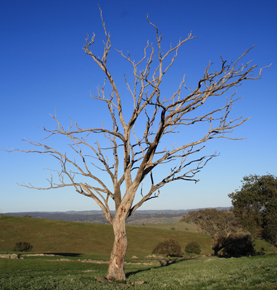 Once was a Shade Tree, once was a Forest
Now a dead reminder of self-righteous colonial exploitation
(Photo: Kate Sherren)
Once was a Shade Tree, once was a Forest
Now a dead reminder of self-righteous colonial exploitation
(Photo: Kate Sherren)
.
References:.
.
- Cremer, K.W (1990) Trees for rural Australia. Inkata Press, Melbourne.
- DNRE (1990) Wildlife needs natural tree hollows. Land For Wildlife Note No. 6 Department of Natural Resources and Environment, Victoria.
- DNRE (1992) Old Trees for Wildlife. Land for Wildlife Note No. 18. Department of Natural Resources and Environment, Victoria.
- Nadolny, C. et al. (1997) A farmers guide to trees and bushland. North West Catchment Management Committee, Tamworth.
- Reid, N. (1996) Managing mistletoe. North West Catchment Management Committee, Tamworth.
- Wakefield, S. & Goldney, D. (1996) Assessing scattered farm trees, in Save The Bush Toolkit Charles Sturt University, Bathurst.
- Wakefield, S. & Goldney, D. (1996) Managing scattered farm trees, in Save the bush toolkit. Charles Sturt University, Bathurst.








